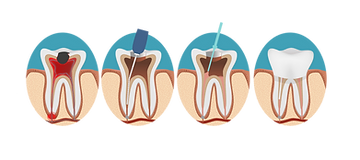Teeth have a hard enamel covering on the outside, but on the inside have a bundle of nerves & blood vessels called the pulp. If the pulp tissue becomes infected, injured or exposed, it can cause severe tooth pain.
How does the pulp get infected or injured?
A variety of factors can cause infection or injury:
- A cavity that is not treated will over time advance deeper into the tooth and infect the nerve or pulp tissue.
- Trauma or hard impact may sever or injure the nerve or blood supply to the tooth.
- A deep crack or fracture of a tooth may expose or injure the nerve.
- Prolonged inflammation/stress on a tooth from extensive dental treatment, advanced periodontal disease, clenching or unresolved sensitivity.
Damaged or dead pulp tissue leads to increased blood flow and cellular activity inside the tooth, which creates increased pressure (and pain) inside the tooth. Without treatment, the dead or injured pulp tissue becomes infected and the infection spreads to the adjacent bone and supporting structures. Over time, the chronic infection leads to tooth loss.
Signs or Symptoms that a Root Canal may be indicated:
- Severe tooth pain with chewing or pressure
- Prolonged sensitivity to heat or cold temperatures
- Discoloration (darkening) of the tooth
- Swelling or tenderness in the adjacent tissues
- A persistent or recurring pimple on the gums
- A lesion or dark spot at the base of the root which would be evident on a dental x-ray
What is Root Canal Therapy?
Root Canal Therapy is a procedure which relieves tooth pain and infection by removing the inflamed or infected pulp tissue from inside of the tooth. Depending on the anatomy and complexity of the root canal, patients may be referred to a local Endodontist (a Specialist in Root Canals) to complete the treatment.
The steps involved in a root canal are:
- The tooth is anesthetized for your comfort.
- An opening is made through the top of the tooth and into the pulp chamber.This relieves the inflammation, infection and pain from the tooth.
- The diseased and inflamed pulp tissue is then removed.
- Medication may be placed inside the tooth if the infection or inflammation is severe.You may also be prescribed antibiotics or anti-inflammatories.
- The tooth is cleaned and disinfected on the inside and the pulp space is filled with a rubber-like material to seal it from future contamination.
- A temporary filling is then placed on top of the tooth where initial access was made to perform the root canal.
- The tooth is then restored with a permanent filling and/or crown to help strengthen it.
Is a Root Canal Painful?
Root canals used to have a reputation for being painful. In reality, most patients report that the procedure itself is no more painful than having a filling placed. The discomfort experienced in the period leading up to dental treatment is truly the most painful period of time, not the root canal procedure itself.
What to Expect After a Root Canal
The root canal procedure should relieve the pain associated with the tooth. Until your tooth is permanently restored following the root canal, it is wise to minimize chewing on the tooth. This will help avoid re-contamination of the interior of the tooth and prevent a fragile tooth from breaking before it is fully protected or restored.
For the first few days following the root canal, the tooth may feel slightly sensitive due to natural inflammation surrounding the root, especially if there was pain or infection before the procedure.
As far as oral health care is concerned, brush and floss regularly and keep the area clean. The final step of the root canal procedure or treatment is the placement of a permanent restoration over the top of the tooth (such as a crown) to help cover and protect the underlying tooth.
What are the risks or complications Associated with a Root Canal?
More than 95 percent of root canal treatments are successful. However, sometimes a procedure needs to be redone due to diseased canal offshoots that were too small or positioned in a manner in which they were not visible or accessible during the initial root canal.
On rare occasions, an instrument may become impinged inside the root or a crack may develop within the root which may complicate future prognosis.
Are there other options than a Root Canal?
The only alternative to root canal therapy is to extract the tooth. Although an extraction may be less expensive at the outset, the empty space left behind may require an implant or a bridge in the future which ultimately would be more costly than root canal therapy.


